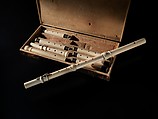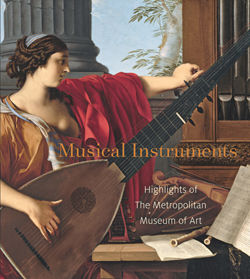Pair of Transverse Flutes
Johann Wilhelm Oberlender (the Elder) German
While wind instruments were generally not favored by gentlemen amateurs and aristocrats, recorders and flutes were notable exceptions. Flutes paired well with the voice and harp, popular instruments of the music room or salon. The flute’s louder volume and ability to produce more dramatic dynamic contrasts led to its dominance over the recorder in both private and public music making in the first decades of the eighteenth century.
Professional musicians generally used flutes made from wood. This pair’s use of ivory and the ornate leather-covered case, which ostentatiously displays the instruments side by side instead of efficiently storing them in stacking trays, as is typical, suggest an aristocratic owner. Pairs of high-quality flutes such as these were sometimes produced for use by a gentleman and his music master.
During the period when they were made, pitch had not been standardized. Each flute in this pair was supplied with three corps de rechange, or alternate middle joints, enabling it to play in tune at a range of different pitch levels.
Due to rights restrictions, this image cannot be enlarged, viewed at full screen, or downloaded.
This artwork is meant to be viewed from right to left. Scroll left to view more.





